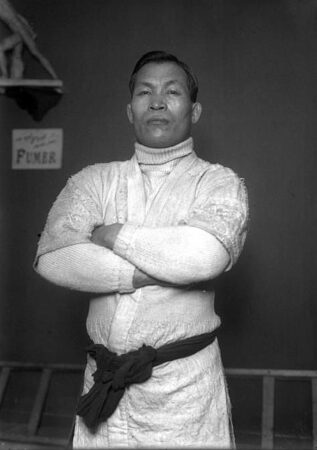Taro Miyake Anglijoje
Prieš imigruodamas į JAV, Taro Miyake pirmą kartą apsigyveno Anglijoje. Miyake padėjo Yukio Tani įkurti dziudo ir džiudžitsu Anglijoje. Miyake ir Tani metė iššūkį profesionaliems imtynininkams į rungtynes kaip jų pastangų kurti savo kovos menus.
Tani dalyvavo iššūkio rungtynėse prieš atvykstant Miyake. Miyake kovojo su savo pirmuoju priešininku, Pats Tani, pabaigoje 1904. Miyake metė Tani po penkių minučių, nors įtariu, kad vyrai bendradarbiavo tarpusavyje dirbdami šiose rungtynėse.

Taro Miyake nuotrauka iš 1914 (Public Domain)
Balandžio 22, 1905, Jimmy Joyce, „Lancashire“ imtynininkas pagaunamas kaip „Can-Can“, Keliavo į Londoną priimti nuolatinio Miyake iššūkio. Vyrai susidūrė su liceumu priešais entuziastingą minią.
Abu vyrai bandė baigti konkursą pateikdami. Minia pirmąsias penkias minutes matė vyrus kaip rankų ir kojų rutulį, nes kiekvienas bandymas pateikti ant kilimėlio yra.
Miyake laimėjo visas ankstesnes savo rungtynes „Three“ ar „Armbar“, Tačiau Joyce'as įrodė, kad ginasi nuo rankos.
Po penkių minučių, dvidešimt penkios sekundės, Miyake privertė Joyce'ą paklusti kulkšnies užraktui. Joyce priėmė savo pralaimėjimą kojos laikymui, bet sakė Miyake.
Joyce pasakojo Miyake'ui, kad Miyake'as panaudojo raištį, kad nugalėtų kitus savo oponentus. Jis jautė, kad Miyake taip pat turi jį nugalėti su rankena arba sutikti su pralaimėjimu.
Dėl nežinomų priežasčių, Miyake priėmė Joyce samprotavimus. Ateityje jis sutiko su juo susitvarkyti. Miyake pareiškė, jei jis neįveikė Joyce'o su raišteliu ar metimu į kitą jų konkursą, Jis prarastų rungtynes su Joyce.
„Miyake“ skleidė dziudo ir Jujitsu per profesionalių iššūkių rungtynes, kurias „Kodokan“ uždraudė. Dr. Jigoro Kano nenorėjo. Tačiau, Pradinė juodųjų diržų grupė, kurie visame pasaulyje skleidė dziudo ir Jujitsu, Griebtas iššūkių rungtynėse.
Šie juodi diržai taip pat pradėjo mokytis kitų stilių Jujitsu prieš treniruotes su DR. Kano savo nauju stiliumi, Dziudo. Jie ir toliau vartojo abi sąlygas, Dziudo ir Jujitsu, apibūdinti jų kovos menų stilių. Kai jie varžėsi profesionaliuose muštynėse, Jie atsiskaitė kaip „Jujitsu“ juodi diržai. Kai jie nurodė studentams, Jie vadino savo meną, „Judo ir Jujitsu“.
Miyake padėjo Tani dešimt metų, prieš keliaudamas į JAV 1914. Be to, kad moko dziudo ir Jujitsu Sietle, „Miyake“ griebėsi iššūkių rungtynėse. „Miyake“ vėliau per savo karjerą dirbo profesionalių imtynių varžybas.
Dziudo ir Jujitsu hierarchija galbūt nepatvirtino jo metodų, tačiau „Miyake“ įrodė esminį dziudo ir Jujitsu plitimą tiek Anglijoje, tiek JAV.
You can leave a comment or ask a question about this or any post on my Facebook page.
Sources: „Nanaimo Daily News“ (Nanonoonas, British Columbia, Canada), Balandis 28, 1905, p. 3

